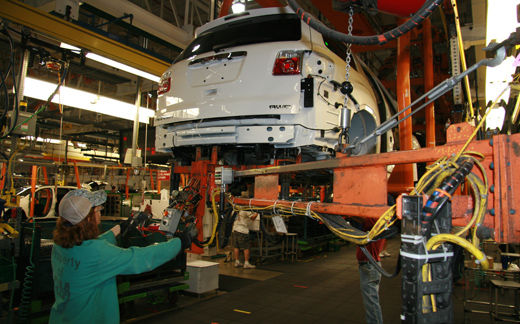
DETROIT – Abolition of the two-tier wage system at the nation’s “Detroit 3” car companies, and raising all workers at those firms to the top tier, is apparently the top bargaining goal of the United Auto Workers, who opened talks with General Motors on July 13.
While UAW President Dennis Williams’ official announcement referred only obliquely to the two-tier wage system, news reports indicated he was more explicit: He wants to kill it.
The union and the Detroit 3 – GM, Ford and, now, FiatChrysler – agreed on the two-tier systems when the carmakers were hemorrhaging money during the Great Recession. Under the system, new hires at the firms make half of what veteran workers in the same jobs make.
The Detroit 3 have been adding jobs ever since they recovered from the recession, and from the bankruptcies of GM and Chrysler. Fiat bought Chrysler in a deal the Obama administration helped engineer. The administration also restructured the bankruptcy terms for the “new GM” to keep that firm alive.
A new contract with GM would replace the current four-year pact, which expires at midnight on Sept. 14. Though the talks with GM were the first to start, Williams told Detroit-based automotive writers the union has yet to pick one of the three for its “pattern contract.”
Unlike past decades, however, the UAW’s “pattern contract,” regardless of which car company signs it, may not be a template for other wage-and-benefits packages, union and non-union nationwide.
That’s because while the car companies were the largest single sector of the U.S. economy in the 1950s and early 1960s – and GM was the nation’s largest employer – those titles have been ceded to the low-wage service sector and to viciously anti-worker anti-union, low-paying Wal-Mart, respectively.
Pattern or not, UAW quoted Williams as saying it’s important to the union to bridge the wage gap “between entry-level and legacy employees.”
The lower tier of GM workers – the new hires – earn between $15.78 and $19.28 hourly. They’re “not middle class the way they should be,” Williams said. Their veteran colleagues on the higher tier earn $28-$33 hourly. The higher rates are for skilled crafts, such as electricians.
“These negotiations will not be easy. But they are no more difficult than those we’ve had in the past,” Williams said. “We have a membership that has, because of the economy, had stagnant wages, and we plan to address that. We all plan to bridge that gap.”
Williams said that as GM and the other two Detroit-based automakers have recovered economically – GM earned $6.6 billion on U.S. operations last year – GM and the UAW created a “very good profit-sharing program” that benefited the workers.
But “after the last two bargaining periods, UAW members made a lot of sacrifices to help GM achieve prosperity. Now, we feel like it’s our time,” said Williams. “Our goal is for GM to prosper, for shareholders and consumers to win and for all UAW members to share in the prosperity of their achievements. We can all win.”
Speaking to the union’s auto bargaining conference in late March, Williams had previously denounced the low-wage second tier.
“A society built on low-wage jobs does not deliver purchasing power,” he said then.
Health care may also come up, but in an odd way, in the talks, Williams indicated in his discussions with the auto writers. That’s because, as part of the rescue, GM sold its health plan for rank-and-file workers to the UAW’s Voluntary Employees Benefits Association (VEBA), which now administers it.
And VEBA apparently runs the plan so well that the company has asked UAW if it would be willing to add the white-collar, non-union share of the workforce to the plan. Doing so would give the plan more income, more members – and more leverage to get reasonable prices from doctors and hospitals.
Photo: UAW workers install a trailer hitch on a vehicle. | GMC Facebook page












Comments